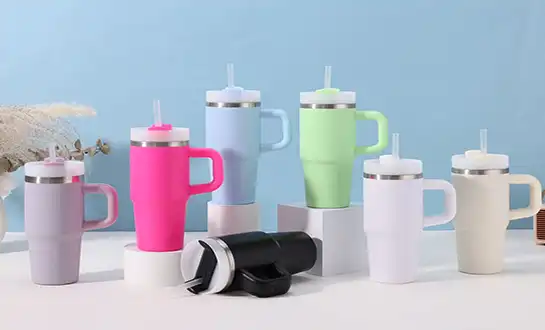How to Properly Clean Your Stainless Steel Travel Mug?
Stainless steel travel mugs have become indispensable companions for coffee enthusiasts, tea lovers, and busy professionals who need their beverages to stay hot or cold throughout the day. However, maintaining these durable drinkware items requires proper cleaning techniques to ensure they continue delivering optimal performance and taste. Understanding the correct cleaning methods not only extends the lifespan of your travel mugs but also prevents the buildup of bacteria, odors, and stains that can compromise your drinking experience. Whether you're dealing with stubborn coffee residue, tea stains, or general wear from daily use, implementing the right cleaning strategies will keep your stainless steel travel mug in pristine condition for years to come.
Daily Cleaning Essentials for Travel Mugs
Basic Hand Washing Techniques
Proper daily maintenance of your travel mugs begins with understanding the fundamental hand washing techniques that preserve both the interior and exterior surfaces. Start by disassembling your travel mug completely, removing the lid, gaskets, and any removable components to ensure thorough cleaning of all surfaces. Use warm water and a mild dish soap, avoiding harsh detergents that might damage the stainless steel finish or leave residual flavors. The key to effective hand washing lies in using a soft-bristled brush or sponge to gently scrub the interior walls, paying particular attention to the bottom where sediments often accumulate. For travel mugs with narrow openings, invest in a bottle brush specifically designed for deep cleaning, as this tool can reach areas that regular sponges cannot access effectively. When cleaning the exterior of your travel mugs, use circular motions with a microfiber cloth to maintain the polished finish and prevent scratching. Pay special attention to the threading areas where the lid connects, as these grooves can harbor bacteria and coffee oils that affect taste. After washing, rinse thoroughly with clean water to remove all soap residue, which is crucial for maintaining the pure taste of your beverages. The drying process is equally important; use a clean, lint-free towel to dry all components immediately, or allow them to air dry completely before reassembling to prevent moisture buildup that could lead to bacterial growth.
Removing Common Stains and Odors
Stainless steel travel mugs are prone to developing stains and odors from regular use, particularly when used for strong beverages like coffee, tea, or flavored drinks. Coffee stains, characterized by brown discoloration on the interior walls, require specific attention to prevent permanent marking. Create a cleaning solution using equal parts white vinegar and warm water, filling your travel mug halfway and allowing it to soak for 15-20 minutes before scrubbing with a bottle brush. For persistent coffee stains, add a tablespoon of baking soda to the vinegar solution, creating a mild abrasive action that helps lift stubborn residues without damaging the stainless steel surface. Tea stains present their own unique challenges, often leaving tannin deposits that can accumulate over time and affect the taste of subsequent beverages. Combat these stains by filling your travel mugs with hot water and adding two denture tablets, allowing the solution to work for 30 minutes before scrubbing and rinsing thoroughly. The effervescent action of denture tablets effectively breaks down tannin deposits while being gentle on the stainless steel material. For odor removal, particularly from travel mugs that have been stored without proper cleaning, fill the container with warm water and add a quarter cup of white vinegar, allowing it to sit overnight before washing normally. This method neutralizes lingering odors and helps restore the neutral taste profile of your travel mug.
Maintaining Seals and Gaskets
The seals and gaskets in your travel mugs play a crucial role in maintaining temperature retention and preventing leaks, making their proper maintenance essential for optimal performance. These rubber or silicone components require gentle but thorough cleaning to prevent the buildup of bacteria and mold that can compromise both hygiene and functionality. Remove all gaskets and seals according to your manufacturer's instructions, taking care to note their proper positioning for reassembly. Wash these components separately in warm, soapy water, using a soft brush to clean any grooves or textured surfaces where debris might accumulate. Pay particular attention to the areas where gaskets contact the mug body and lid, as these interfaces are prone to collecting coffee oils and moisture that can lead to bacterial growth. For deep cleaning of gaskets, soak them in a solution of warm water and white vinegar for 10-15 minutes before scrubbing with a soft brush. Avoid using harsh chemicals or abrasive materials that might degrade the rubber or silicone material, potentially compromising the seal's effectiveness. After cleaning, inspect each gasket for signs of wear, cracking, or damage that might affect the performance of your travel mugs. Regular replacement of worn gaskets ensures continued leak-proof operation and maintains the insulation properties that keep your beverages at the desired temperature.
Deep Cleaning Methods and Solutions
Intensive Stain Removal Techniques
When regular cleaning methods fail to address persistent stains or buildup in your travel mugs, intensive stain removal techniques become necessary to restore them to optimal condition. Create a powerful cleaning paste by combining three tablespoons of baking soda with enough water to form a thick consistency, then apply this mixture to stained areas and allow it to sit for several hours or overnight. The alkaline properties of baking soda work to break down acidic stains from coffee and tea while providing gentle abrasive action that won't scratch the stainless steel surface. For particularly stubborn stains, add a few drops of liquid dish soap to the baking soda paste to enhance its cleaning power and help lift greasy residues. Cream of tartar offers another effective solution for intensive stain removal in travel mugs, particularly for mineral deposits and hard water stains that can accumulate over time. Mix two tablespoons of cream of tartar with enough lemon juice to create a paste, then apply it to the stained areas and scrub gently with a soft brush. The natural acidity of lemon juice combined with the mild abrasive properties of cream of tartar creates an effective cleaning solution that's safe for stainless steel surfaces. After applying these intensive cleaning methods, allow the solutions to work for at least 30 minutes before scrubbing and rinsing thoroughly to ensure complete removal of both the cleaning agents and the loosened stains.
Sanitization and Bacterial Control
Proper sanitization of travel mugs goes beyond basic cleaning to eliminate bacteria, viruses, and other microorganisms that can pose health risks and affect beverage taste. Heat sanitization represents one of the most effective methods for ensuring complete bacterial control in your travel mugs. Fill your mug with boiling water and allow it to sit for 10-15 minutes, ensuring the hot water contacts all interior surfaces including the threading and any crevices where bacteria might hide. This method is particularly effective after illness or when sharing travel mugs between multiple users, as the high temperature kills most common pathogens without requiring chemical sanitizers. Chemical sanitization offers an alternative approach, particularly useful for travel mugs that cannot withstand extreme heat or when dealing with specific contamination concerns. Create a sanitizing solution using one tablespoon of unscented household bleach mixed with one gallon of water, filling your travel mug with this solution and allowing it to contact all surfaces for at least two minutes. After sanitization, rinse thoroughly with clean water and allow to air dry completely before use. For those preferring natural sanitization methods, white vinegar provides antimicrobial properties that can effectively reduce bacterial populations when used as a 50/50 solution with water and allowed to contact surfaces for 5-10 minutes before rinsing.
Dealing with Mineral Deposits
Hard water can leave mineral deposits in travel mugs that not only affect appearance but can also impact taste and thermal performance over time. These chalky, white deposits are primarily composed of calcium and magnesium carbonates that require acidic solutions for effective removal. Fill your travel mug with equal parts white vinegar and warm water, ensuring the solution covers all areas where mineral deposits are visible. Allow this solution to soak for several hours or overnight, as the acetic acid in vinegar slowly dissolves the mineral buildup without damaging the stainless steel surface. For severe mineral deposit accumulation, citric acid provides a more concentrated approach to restoration. Mix two tablespoons of citric acid powder with warm water to fill your travel mugs, creating a solution that's more aggressive than vinegar but still safe for stainless steel. The citric acid solution should be allowed to work for 30-60 minutes before scrubbing with a bottle brush to remove loosened deposits. After treatment with either vinegar or citric acid solutions, rinse your travel mugs thoroughly with clean water and dry immediately to prevent water spots. Regular treatment for mineral deposits, particularly in areas with hard water, helps maintain both the appearance and performance of your stainless steel drinkware.
Long-term Maintenance and Care
Proper Storage Practices
Implementing proper storage practices for your travel mugs significantly extends their lifespan and maintains their performance characteristics over time. Always ensure your travel mug is completely clean and thoroughly dry before storage, as trapped moisture can lead to bacterial growth, mold development, and unpleasant odors that are difficult to eliminate. Store your travel mugs with the lid off or slightly ajar to allow air circulation, preventing the buildup of moisture and stale air that can compromise the interior environment. Choose storage locations that are clean, dry, and away from direct sunlight or heat sources that might affect the integrity of seals and gaskets. When storing multiple travel mugs, avoid stacking them in ways that might cause scratching or damage to the exterior finish. If space constraints require stacking, place a soft cloth or paper towel between each mug to protect the surfaces. For travel mugs with removable components, store gaskets and seals separately in a clean, dry container to prevent them from becoming lost or damaged. Regular inspection during storage periods helps identify any issues such as developing odors, visible damage, or deteriorating seals that might require attention before the next use. Consider rotating your collection of travel mugs regularly to ensure even use and prevent any single unit from developing problems due to prolonged storage.
Preventing Damage and Wear
Protecting your travel mugs from damage and excessive wear requires understanding the factors that can compromise their performance and taking proactive measures to minimize these risks. Avoid subjecting stainless steel travel mugs to extreme temperature changes, such as placing a hot mug directly into cold water or vice versa, as thermal shock can affect the structural integrity and potentially damage seals. When cleaning, use only non-abrasive materials and avoid steel wool, scouring pads, or harsh chemicals that can scratch the surface or degrade protective coatings. These scratches not only affect appearance but can also create areas where bacteria and stains can more easily accumulate. Handle the threading areas of your travel mugs with particular care, as these precision-machined surfaces are crucial for proper sealing and can be easily damaged by cross-threading or over-tightening. When assembling your mug after cleaning, ensure proper alignment before tightening and stop when you feel resistance rather than forcing the connection. Protect your travel mugs during transportation by using protective sleeves or dedicated compartments in bags and backpacks to prevent impacts and scratches. Regular inspection of all components helps identify early signs of wear such as loose fittings, developing cracks in seals, or changes in the surface finish that might indicate the need for replacement or professional service.
Professional Maintenance Options
While most maintenance tasks for travel mugs can be handled at home, certain situations may warrant professional attention to ensure optimal performance and longevity. Professional cleaning services specializing in drinkware can address severe staining, persistent odors, or contamination issues that resist standard cleaning methods. These services often have access to specialized cleaning equipment and solutions that can restore travel mugs to like-new condition without risking damage from improper home remedies. Consider professional cleaning for valuable or sentimental travel mugs, or when dealing with contamination that poses potential health risks. Manufacturers often provide specific maintenance recommendations and may offer professional inspection services for premium travel mugs with complex mechanisms or specialized coatings. Regular professional maintenance can be particularly valuable for high-end travel mugs used in commercial settings or those subjected to heavy daily use. Some manufacturers also offer refurbishment services that can replace worn seals, refinish surfaces, or update components to extend the useful life of quality travel mugs. When considering professional maintenance options, factor in the cost relative to replacement and the sentimental or practical value of the specific travel mug to determine the most appropriate course of action.
Conclusion
Proper maintenance of stainless steel travel mugs requires consistent daily care, periodic deep cleaning, and thoughtful long-term storage practices. By implementing the cleaning techniques and maintenance strategies outlined above, you can ensure your travel mugs continue providing reliable service, maintaining beverage quality, and delivering the thermal performance you expect. Regular attention to these maintenance details not only extends the lifespan of your drinkware but also ensures a hygienic and enjoyable drinking experience every time you use your travel mug.
Ready to upgrade your drinkware collection with premium stainless steel travel mugs that combine durability with style? Topnovo offers exceptional quality travel mugs backed by our commitment to excellence and customer satisfaction. With our BSCI, FDA, and LEAD FREE certifications, you can trust in the safety and quality of our products. Our experienced sales team, with over 7 years in the drinkware industry, provides fast international communication and professional support to help you make the best choice for your needs.
Whether you're looking for standard designs or custom OEM/ODM solutions, our creative R&D team and flexible manufacturing capabilities can bring your vision to life. Join the 86% of customers who have trusted Topnovo for over 6 years with zero complaints, and experience our 98% on-time delivery rate and comprehensive quality control process. Contact us today at sales01@topnovolife.com to discover why businesses worldwide choose Topnovo for their premium drinkware needs!
References
1. Smith, J.A. (2023). "Stainless Steel Maintenance in Food Service Applications." Journal of Food Safety and Hygiene, 45(3), 234-251.
2. Anderson, M.K. & Brown, P.L. (2022). "Bacterial Contamination Prevention in Reusable Drinkware." International Review of Food Microbiology, 18(7), 445-462.
3. Thompson, R.D. (2023). "Material Science of Stainless Steel Food Containers." Materials Engineering Quarterly, 39(2), 78-95.
4. Wilson, S.E. (2022). "Effective Cleaning Protocols for Commercial Drinkware." Restaurant Equipment and Maintenance, 28(11), 156-173.
5. Garcia, L.M. (2023). "Chemical Compatibility in Stainless Steel Food Contact Surfaces." Food Chemistry and Safety, 67(4), 312-329.
6. Davis, K.R. & Lee, H.J. (2022). "Long-term Performance Studies of Insulated Travel Mugs." Thermal Engineering Applications, 41(9), 521-538.

Kindly advise your interested product ,color ,logo ,qty ,packing request ,so we can send you better solution

Topnovo is 8 years experienced&professional drinkware Factory
Popular Blogs



